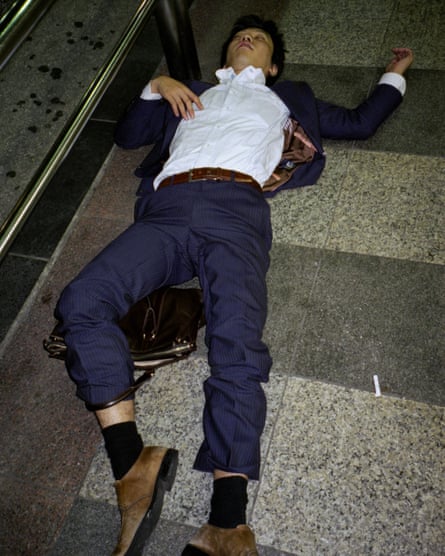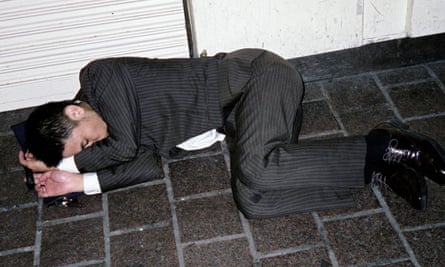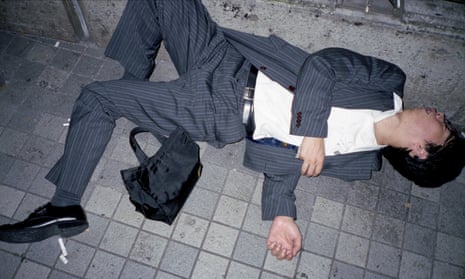A well-to-do man is dressed for success: black lace-ups, tie and a sharp pinstripe suit. So why is he asleep on a Tokyo pavement in the dead of night, curled up like a foetus in the womb?
High Fashion, a new book, shows that this is no isolated incident. In photograph after photograph, lone suited-and-booted businessmen sleep in the middle of the city. A couple of drinks after work can sometimes get out of hand – many of us have been there. But in the deferential, work-hard/play-hard, corporate culture of Japan, getting drunk and ending up stranded without a bed seems to happen all the time.
“When the last train is gone, a city bench or the street are the only options left. For most, a hotel is too expensive,” says Paweł Jaszczuk. Initially, the Warsaw-born, Tokyo-based photographer says that his eye was attracted by the sleeping salarymen on purely aesthetic grounds. “The contrast between these well-dressed men and the street grabbed my attention, and the message came later.”

From Shinjuku to Shibuya to Shimbashi, Jaszczuk would cycle around train stations and karaoke bars in Tokyo’s business and entertainment districts between 11pm and 3am, looking for subjects slumbering in the streets. “They had to be well dressed, with an interesting pose and something extra to make the image special,” he notes. “I wanted a fashion-magazine look.”
Over time, a meaning became apparent to Jaszczuk. “The pictures show people who are used, who are overworked, overstressed and exhausted. Do we really want to end up like this?”
This theme comes through clearly in the cleverly designed book, which is styled like a high-end glossy magazine, the flow of images creating an increasing sense of being crushed and stretched. This impression is heightened by well-chosen image pairings on each two-page spread, presenting near-identical shapes or complementary poses.
Some of his flashlit sleepers look like murder victims (perhaps killed by excessive work), just like the New York photographer Weegee might have shot them. Others recall Robert Longo’s larger-than-life portraits Men in the Cities (Longo based his drawings on photographs), not only in their contorted suit-clad subjects, but also thematically: the impression that they are being bent out of shape by the society they live in. But Jaszczuk’s pictures go further: they suggest we’re all in the same exploitative capitalist-consumerist bed, and we’re all asleep as we turn somersaults.
Jaszczuk’s route to photography – and to Tokyo – was unplanned. “In my early 20s, I left Poland in pursuit of adventure and went to Sydney to study graphic design,” he says. “After a while I got bored with sitting behind a desk. I needed some action. Photography came naturally to me.” In Sydney, he met a Japanese woman, Reiko, whom he went on to marry. “After graduating, we decided to go to Japan.”

Jaszczuk’s current project also critiques capitalist exploitation. “3000! is a portrait of energy drinks – very colourful and graphic images with a strong hidden message,” he explains. “It’s about products made by pharmaceutical companies to make us more effective, give us more energy, make us more powerful, stronger and ‘better’, so we can work more and produce more. But with what effect on ourselves?”
Another eye-popping project, ¥€$U$, is a “grotesque picture of the Catholic church as a business institution, a corporation aiming at maximisation of profits where the image of the saints is nothing but an object for sale.” From Virgin Mary lamp stands to Jesus-emblazoned hotpants, ¥€$U$’s mix of kitsch and sex with the supposedly sacred highlights the deep profanity of today’s world.
“My photography matures with me, gets more serious with age,” he says. “I try to raise questions, to encourage people to think about themselves, and about human nature.”
The most famous photographer of the nocturnal city thought along similar lines. Brassaï, who chronicled Paris at night almost a century ago, believed that “the purpose of art is to raise people to a higher level of awareness than they would otherwise attain on their own”. If these somnolent 21st-century Tokyo salarymen shock some of us into thinking more critically about our own role in the world, then Jaszczuk is not only succeeding by his own yardstick. He is continuing a great artistic lineage.

Comments (…)
Sign in or create your Guardian account to join the discussion